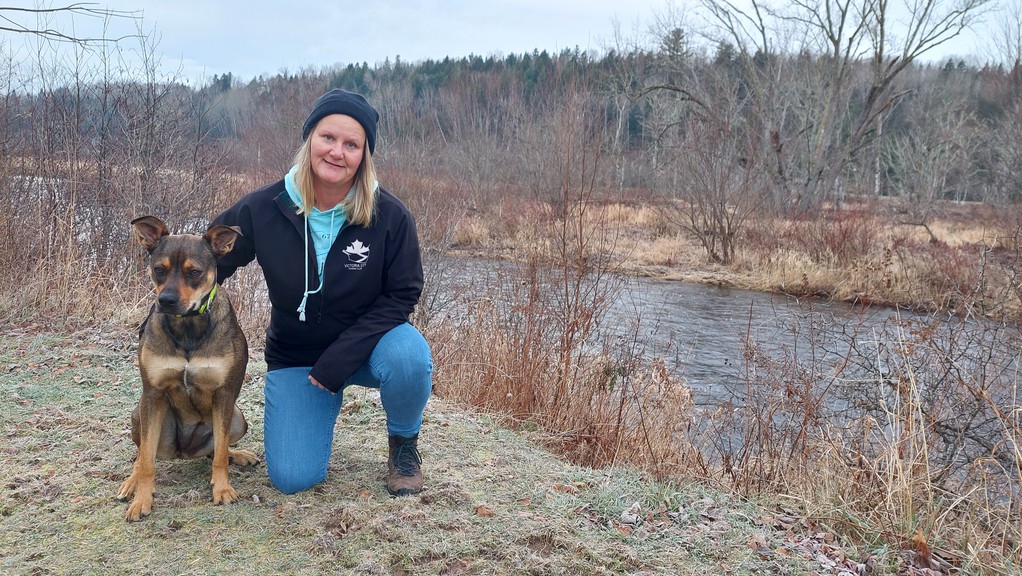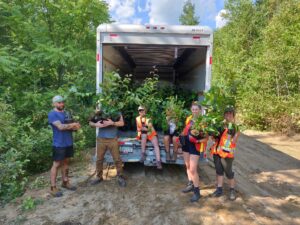Telegraph Journal Article by John Chilibeck
December 22, 2022

Kari Davis says the first sign of trouble was the crashing and banging outside her home.
The financial planner from British Columbia was spending her first winter in New Brunswick in 2018 after she and her husband sold everything and moved east to run an old campground in Durham Bridge, north of Fredericton.
She hadn’t anticipated what would happen if there was a January thaw on the Nashwaak River, just a stone’s throw from her cabin. But she was about to find out.
A large ice jam just downriver caused ice and water to crash the bank and flood her property.
“It was a little scary,” she said, describing the ice sheets that careened up over the bank at almost a foot thick. “I was here by myself and I had to evacuate. It’s the one and only time I did load the dog in the truck and left. We just had no idea what would happen.”
In the end, the water only went up on either side of her house. People nearby came to see if she was OK and warned her to stay away from the river’s edge.
“We have a great group of neighbours who came out and checked on me, and then they gave me crap for going to the other end of the property in my snowshoes to investigate. They said it was too dangerous. They told me, ‘No, there will be three surges, and you can’t go until they’re gone,’ and I was, like, ‘what?'”
A flood-proof plan
The Durham Bridge RV Resort had flooded before, in 2010, when several trailers were washed away, a factor that led the previous owners to abandon the business.
Since the scary experience and a slight scouring of the riverbank, Davis and her husband took several measures to flood-proof their property, which includes 34 full-service seasonal sites, a clubhouse and pool.
They raised their house two feet on concrete footings. The Nashwaak Watershed Association planted a dozen or so willows along the upper and lower banks. When they and their neighbour cut down several mature pine trees that were damaging their roofs, they left the stumps five feet high, to block any ice sheets from hitting their homes. And seasonal trailers are not allowed to be parked on the property during the winter.
The campground is similar to thousands of private properties along the province’s waterways and coastlines at risk of erosion and flood damage.
In recent weeks, there have been calls inside the legislature from the opposition Liberals and Greens for government compensation for people whose oceanfront properties collapsed into the sea following storms caused by hurricanes Fiona and Nicole in the fall. Premier Blaine Higgs has promised that federal disaster assistance is on the way to help.
Thousands of properties at risk
One specialist says it shouldn’t be a big surprise where coastal and riverfront properties are eroding.
Sabine Dietz, the executive director of CLIMAtlantic, says while predicting the timing of a catastrophic event is difficult, the provincial government already has excellent flood mapping and a database of the worst erosion spots.
“The worse climate change gets, the more challenges we’ll have along our waterways,” she said in an interview. “We’ve known for many, many years that there are areas at high risk. All you have to do is look at the flood portal that the provincial government has and the erosion database they have as well. People working in these fields have been raising red flags for many, many years.”
A report released in August by Ottawa gives a good idea how many New Brunswick property owners are at risk.
The paper by Canada’s Task Force on Flood Insurance and Relocation says that New Brunswick private property owners will suffer an annual average loss of $104 million due to flooding. All told, there are 48,951 residential properties in New Brunswick within the top ten per cent for risk of flooding, and 6,867 residential properties within the top one per cent.
Dietz said it made sense to help people whose properties had been developed decades ago along waterways, but that new development in risky areas should be stopped.
She said in some cases, coastal shorelines could be protected by re-creating what she called “living shorelines,” by building back sand dunes, anchored by beach grasses with long roots.
“You want a buffer between people and the waves,” she said. “The dunes of Bouctouche are an excellent example of this. Those dunes move and shift, but they also protect the Town of Bouctouche from erosion.”
Riverbanks, meanwhile, can be shored up by the planting of native trees and bushes, such as willows and silver maples, species that thrive in flood plains, while alders are excellent protection for stream banks.
She strongly recommended against rock armouring, which she described as a temporary emergency solution to protect critical infrastructure such as roadways, but is poor for long-term protection against erosion.
She said during Hurricane Fiona many people in Nova Scotia found out that hard barriers can often be breached by huge waves that cause damage and erosion to the other side. They also tend to compound the problems for neighbouring property owners who don’t have a rock armour.
Time to retreat?
In many instances, the specialist thinks governments should encourage property owners to move back from shorelines, what she called “managed retreat.”
“We need to look everywhere along flood plains and shorelines where it’s eroding really fast and get out of the way of the risk. We can’t actually stop it with rocks or soft measures. We can just slow it down.”
She said one of the problems was local governments, desperate for funds, often support risky development because waterfront properties are popular and bring in a lot of property tax money.
Dietz also said it was important for governments to do a careful cost-benefit analysis before taking on expensive measures to protect shoreline.
“I would put my emphasis on helping people retreat,” she said. “Because if you try to protect everyone in the highest-risk areas, you’d have to put in a massive amount of structures, which are not the long term solution to this problem. They are temporary measures that won’t last forever.”
As for Davis, she said she supports government compensation for property owners who sustain damage is someone else is at fault.
“If the government has allowed activities upriver that have caused drastic changes to the landscape, for example deforestation or putting in a mine or clearing lots, they should compensate people downriver in some way. If that leads to erosion downriver, they should compensate property owners for some of it.”
She made the case that property owners should seek flood insurance if they want to live in risky areas such as hers. “People say you can’t get flood insurance. But you should look into it. I got flood insurance. Granted there’s a large deductible of $25,000 but if the entire place goes, I’ll gladly pay that.”
To see the original article, check out the Telegraph Journal.

